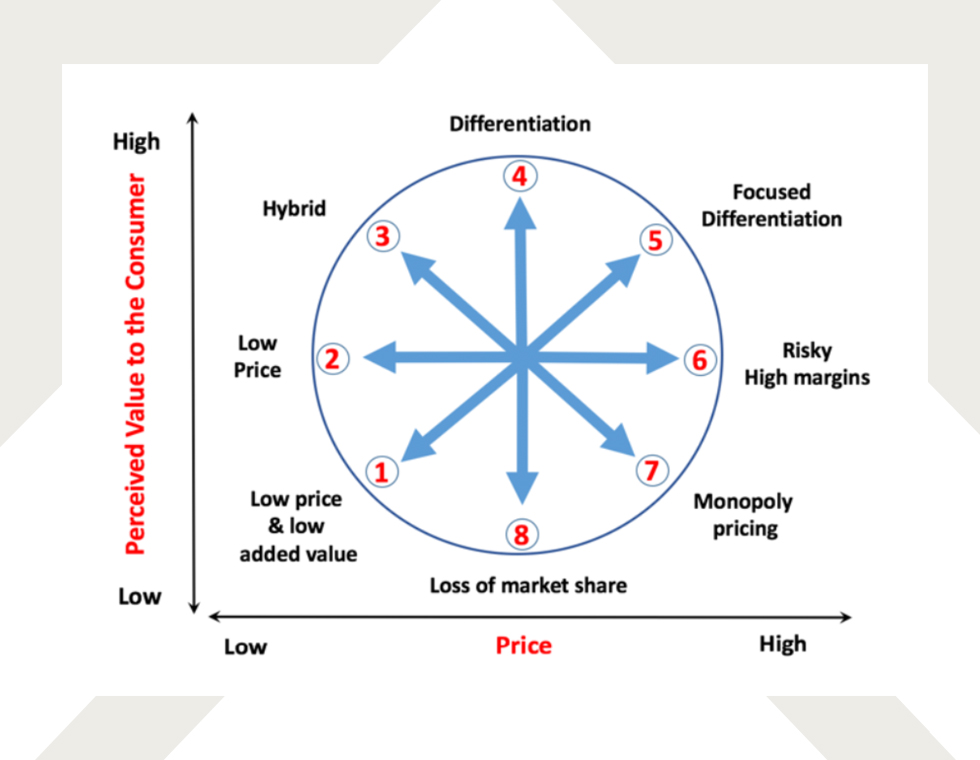
Strategic Frameworks Bowman’s Strategy Clock
Bowman’s Strategy Clock is a strategy framework used to analyze the competitive position of a company in comparison to the offerings of competitors. The clock represents eight possible strategies in four quadrants defined by the axes of price and perceived added value. The strategy clock is a tool that has a bias towards helping to direct competitive strategy to increase market share.
1 – Low Price / Low Value Added
This is not a very competitive position for a business. The product is not differentiated, and the customer perceives very little value, despite a low price. This can be described as a bargain basement strategy. The only way to remain competitive is to be as cheap as possible and hope that no-one else is able to undercut you.
2 – Low Price
Businesses positioning themselves here look to be the low-cost leaders in a market. A strategy of cost minimization is required for this strategic choice to be successful and is often associated with economies of scale. Profit margins on each product are low, but the high volume of output can still generate high overall profits. Competition amongst businesses with a low price position is usually intense – often involving price wars.
3 – Hybrid
As the name implies, a hybrid position involves some element of low price (relative to the competition), but also some product differentiation. The aim is to persuade consumers that there is good added value through the combination of a reasonable price and acceptable product differentiation. This can be a very effective positioning strategy, particularly if the added value involved is offered consistently.
4 – Differentiation
The aim of a differentiation strategy is to offer customers the highest level of perceived added value. Branding plays a key role in this strategy, as does product quality. A high quality product with strong brand awareness and loyalty is perhaps best-placed to achieve the relative prices and added-value that a differentiation strategy requires.\
5 – Focused Differentiation
This strategy aims to position a product at the highest price levels, where customers buy the product because of the high perceived value. This is the positioning strategy adopted by luxury brands, who aim to achieve premium prices by highly targeted segmentation, promotion and distribution. Done successfully, this strategy can lead to very high profit margins, but only the very best products and brands can sustain the strategy in the long-term.
6 – Risky High Margins
This is a high risk positioning strategy that you might argue is doomed to failure – eventually. With this strategy, the business sets high prices without offering anything extra in terms of perceived value. If customers continue to buy at these high prices, the profits can be high. But, eventually customers will find a better-positioned product that offers more perceived value for the same or lower price. Other than in the short-term, Risky High Margins is an uncompetitive strategy.
7 – Monopoly Pricing
Where there is a monopoly in a market, there is only one business offering the product. The monopolist doesn’t need to be too concerned about what value the customer perceives in the product – the only choice they have is to buy or not. There are no alternatives. In theory the monopolist can set whatever price they wish. Fortunately, in most countries, monopolies are tightly regulated to prevent them from setting prices as they wish.
8 – Loss of Market Share
This position is a recipe for disaster in any competitive market. Setting a middle-range or standard price for a product with low perceived value is unlikely to win over many consumers who will have much better options (e.g. higher value for the same price from other competitors)